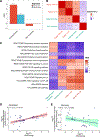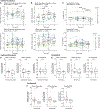Biological age is increased by stress and restored upon recovery
- PMID: 37086720
- PMCID: PMC11055493
- DOI: 10.1016/j.cmet.2023.03.015
Biological age is increased by stress and restored upon recovery
Abstract
Aging is classically conceptualized as an ever-increasing trajectory of damage accumulation and loss of function, leading to increases in morbidity and mortality. However, recent in vitro studies have raised the possibility of age reversal. Here, we report that biological age is fluid and exhibits rapid changes in both directions. At epigenetic, transcriptomic, and metabolomic levels, we find that the biological age of young mice is increased by heterochronic parabiosis and restored following surgical detachment. We also identify transient changes in biological age during major surgery, pregnancy, and severe COVID-19 in humans and/or mice. Together, these data show that biological age undergoes a rapid increase in response to diverse forms of stress, which is reversed following recovery from stress. Our study uncovers a new layer of aging dynamics that should be considered in future studies. The elevation of biological age by stress may be a quantifiable and actionable target for future interventions.
Keywords: aging; biological age; dynamics; epigenetic aging clocks; recovery; stress.
Copyright © 2023 Elsevier Inc. All rights reserved.
Conflict of interest statement
Declaration of interests The authors declare no competing interests.
Figures





References
Publication types
MeSH terms
Grants and funding
LinkOut - more resources
Full Text Sources
Other Literature Sources
Medical
Molecular Biology Databases

